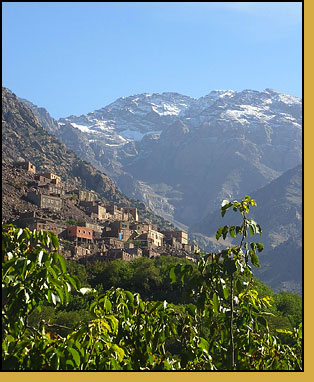



Morocco & Andalusia: The High Atlas Mountains
 The continent’s longest range, stretching from the Atlantic shores to Tunisia, with North Africa’s highest summit, the nearly 14,000-ft Mt. Toubkal just South of Marrakech, the High Atlas is also the guardian of the purest traditions of Morocco’s indigenous inhabitants, the Berber tribesmen. With many nooks still cut off from the outside world by snow for months, survival is deemed best by following centuries-old traditions of life, work, hospitality and rites that accompany the passage of seasons. In between snow lasting at the higher elevations sometimes through June, dramatic canyons, serene green valleys and hamlets of multi-level adobe homes girdled by centuries-old walnut trees, the range presents an idyllic mountain environment. The late summer is the festive season, when one might fall upon local celebrations, with the finest of traditional costumes, jewelry and folklore on display.
The continent’s longest range, stretching from the Atlantic shores to Tunisia, with North Africa’s highest summit, the nearly 14,000-ft Mt. Toubkal just South of Marrakech, the High Atlas is also the guardian of the purest traditions of Morocco’s indigenous inhabitants, the Berber tribesmen. With many nooks still cut off from the outside world by snow for months, survival is deemed best by following centuries-old traditions of life, work, hospitality and rites that accompany the passage of seasons. In between snow lasting at the higher elevations sometimes through June, dramatic canyons, serene green valleys and hamlets of multi-level adobe homes girdled by centuries-old walnut trees, the range presents an idyllic mountain environment. The late summer is the festive season, when one might fall upon local celebrations, with the finest of traditional costumes, jewelry and folklore on display.
What to do
You can appreciate the mountains’ majesty, though not so much the culture, by vehicle on drives South of Marrakech, especially the Test-pass road to Taroudant and the road to ski station Oukaïmeden, as well as the Tichka-pass road to Ouarzazate. To get closer to the culture, the easiest access (and thus the most visited) is the Imlil area of the Mt. Toubkal National Park, just over an hour from Marrakech. There a variety of paths can be undertaken on foot or by mule, crossing terraced fields and their orchards, and visiting local hamlets to observe their daily ways of life. For the adventure seekers, even a chance to climb Mt. Toubkal. For an even better look at the culture, you need to head to the Central Range, the Atlas’s most isolated and thus most rewarding for cross-cultural interactions. The region may be reached on a 5-hr drive from Marrakech and, once there, hikes or mule rides of anywhere from a half-day to over 10 days will expose to you this world seemingly lost in time, while staying in simple inns converted from local homes (some camping is required on longer treks). Also in the region is one of Morocco’s most beautiful yet overlooked natural sites, the Ouzoud waterfalls.
Sites: While the culture, unique architecture and breathtaking scenery are the main reasons to head into the High Atlas, there are major historic sites within the range as well. The recently restored Tin Mal mosque/fortress was the cradle of the 12th-C. Almohad Berber dynasty, whose eventual empire extended East as far as central Libya and North into central Spain. It is the oldest example of the majestic architectural style the Almohads created and spread throughout their domains. Telouet, the largest fortress ever built in the Atlas, was the lair of the powerful Glaoua clan that controlled nearly all of southern Morocco through 1956! Both Tin Mal and Telouet are accessible by road. The Yagour plateau is one of Morocco’s two richest sites of pre-historic rock art, with hundreds of images of animals, people and mystical symbols; accessible only on foot or by mule. Zawyiat Ahansal village is thought to have the oldest surviving examples of pure Berber architecture, its majestic buildings of layered stone, some 7 stories high, having withstood the onslaught of weather over the centuries; accessible by all-terrain vehicles
Other activities: Horseback riding at the mountain equestrian center of Ouirgane. Downhill skiing (Dec-Feb) at Oukaïmeden, the only station where your equipment is carried to the highest elevations by mules! Mountain skiing in the Ayachi and Mgoun ranges. Whitewater rafting on the Ahansal, Ourika and Mgoun rivers. Rock climbing in the Todgha, Dades and Ahansal valleys. All-terrain biking throughout the range.
A Moroccan gazetteer: Tangier | Rabat & Casablanca | Andalusia | Meknes & Volubilis | Fes | Marrakech | The High Atlas | The Middle Atlas | Taroudant & the Anti Atlas | On the Sahara's Edge | The Atlantic Coast | Jewish Heritage | Architecture | Festivals
Plan your trip: Sample Itineraries | Hotels | Trip Request Form | Morocco ABCs